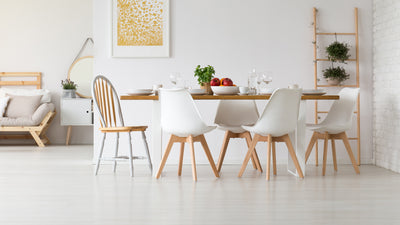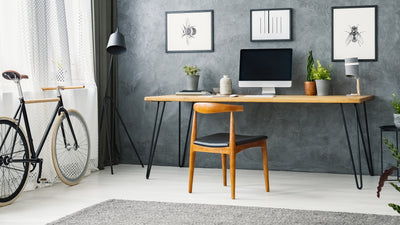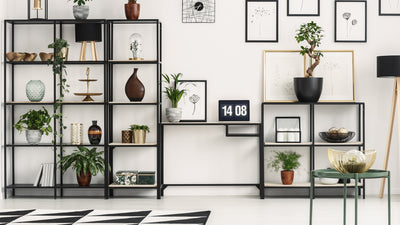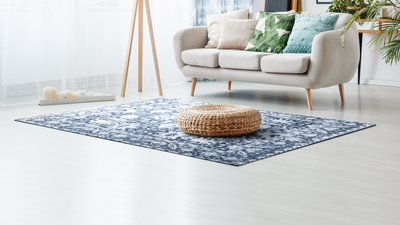How to Choose a Standing Desk
Have you ever felt the toll of working in a sedentary office job? You wouldn’t be the only one. At least 80 per cent of Australians report some sitting involved in their jobs, while 50 per cent spend their whole work day sitting down, according to Worksafe QLD.
Sitting might not seem like a big deal – and it certainly might feel better than standing, at least initially! But a sedentary job can lead to real complications down the line. Sitting for long periods has been linked to a higher risk of cardiovascular disease, obesity, musculoskeletal disorders, neck pain and poor mental health. With the rise of the knowledge economy, and more people working deskbound, it's important to look for ways to reduce sedentary time.
Thankfully, technology has also caught up to the demand, and there is a solution to suit everyone: the standing desk.
What is a standing desk?
A sit-stand desk is a desk that can be height adjusted so that the user can convert between standing and sitting throughout the day. This is either done manually or with electric motors. The standing desk can be used by anyone according to their needs and is a great accessibility tool as well as a thoughtful health initiative. If you experience restlessness at work, feel uncomfortable sitting or standing for extended periods, have a health condition, or simply want to look after yourself, you should consider creating an active workspace and making the switch to a standing desk.
There are a range of standing desks to choose from, which is why at Artiss we’ve compiled this easy buying guide to find your perfect standing desk.
What is the best standing desk?
There are several different types of standing desks, each with different features to suit your lifestyle, health goals, and budget. The main differences are the methods you use to raise or lower the desk.
Before jumping into the different types of standing desks, regardless of your purchase decision, your monitor should be at eye level and your arms at a 90-degree angle with your elbows by your side. This is the most ergonomic standing position. So, let's dive in!
Standing desk converters

Standing desk converters are the cheapest option and don’t require an entire desk replacement. A sit-stand desk converter is a stand that you place on your existing desk and can adjust manually or electrically. They come in a variety of models, styles and price points. Of course, the switch between standing and sitting will be more cumbersome if you have to pull out a piece of equipment and manually adjust it every time, the cheaper models are usually less stable and prone to wobbling. Ultimately, ease of use will depend on the make of the sit-stand converter and the model you choose.
Manual height-adjustable desks

Manual height-adjustable desks are usually adjusted with a crank, or by moving the desk height up and down with bolts or slots. Manual adjustable desks are cheaper to buy and won’t eat into your energy bill, but they make a lot more noise than other models which might disturb a busy office. Furthermore, it can be annoying to adjust an adjustable standing desk by hand, especially if you only need to make a small adjustment.
Pneumatic or hydraulic desks

Pneumatic or hydraulic desks technically require manual labour, in that you have to switch a lever. The desk will move quietly, quickly and reliably, but you may have to exert pressure for small adjustments. Depending on the model, it might not have the weight capacity you need for a busy desk either.
Electric standing desks
Electric height-adjustable desks are easy on the arms but might be loud in a quiet office. Our expert tip is to pick a sit-stand desk that advertises being quiet, somewhere between 40-60 decibels. Some electric desks have the bonus of memory settings so you can preset your favourite positions.
Exercise desks

If simply standing doesn’t appeal to you, there are also desks that allow you to exercise while you work. The most common of these standing desks are treadmill or bike desks, which combine an exercise machine with an ergonomic sit-stand desk to help you keep active while working. For treadmill desks, you can either get a combo desk, a treadmill base to go under your existing desk, or convert your treadmill into a workspace with a shelf or tablet holder. If you want a bike, you can get a mini exercise bike that sits under your desk or a bike with a built-in desktop.
How much space do you need for a standing desk?

The type of desk you purchase may depend on load capacity and your space requirements. For example, if you have a large computer, three monitors and a book collection, you’ll need a desk with a greater load capacity. If you only have a couple of items and a laptop, then a smaller desk with a smaller load capacity or even a simple converter will be more affordable and easier to configure. You’ll also have to consider if you’d rather spread out at work or if you’re happy with a smaller space. Standing desks typically only come with desk space, not storage space. If you're short on desktop options, you may also need to consider purchasing additional office furniture such as a storage locker or lockable drawers to position under your desk frame.
Minimum and maximum height
If you're especially tall or short, you’ll need an adjustable standing desk with extra flexibility when it comes to minimum and maximum heights. For an optimal experience, you’ll need a height-adjustable standing desk where your monitor can be positioned at eye level, your elbows at your sides, and your arms on a 90-degree angle when writing or typing.
Materials
Materials and styles are limited for standing desks, but that doesn’t mean you can’t find something to match your decor. Typically, sit-stand desks are made from a medium-density fiberboard (MDF) or hard-wearing melamine board covered with a veneer. Low-density fiberboards, bamboo and hardwood options are also available, varying in durability and price points. If you'd like to invest in a surface that helps improve performance, you can purchase sit-stand desks with special tabletop surfaces that enable mouse tracking, essentially transforming the entire desk into your mouse pad.
If you have a modern interior style, you may want to choose a desk with a wood grain, natural oak or light bamboo surface to match your decor. If you lean more traditional when styling your home, then you may opt for a darker wood grain or even a dark bamboo surface. If your interior is Hamptons-style, French provincial or modern minimalist, then a solid-coloured laminate in black or white might be in your future.
Maintenance of standing desks
Most desktop surfaces will be even and smooth, making them easy to dust down, though wood desks may require more maintenance in terms of buffing out scratches and reapplying lacquers and sealants. Otherwise, your core maintenance issues will come from the mechanics.
To avoid any issues with your desk, be considerate of the following:
-
Avoid interrupting an electric standing desk while it’s moving.
-
Pay attention to the load capacity of your standing desk. If you exceed the recommended weight limit, it will put a strain on the core components.
-
Clean up liquid spills immediately. It will not only damage the desktop surface but also risk clogging or breaking any electrical components.
-
Make sure all the other components (e.g. cables) are in working order, out of the way, and plugged in. Some standing desks come with cable management holes, but you can always purchase a cable management system if this isn't the case.
Are sit-stand desks worth it?
The short answer is: yes. According to the 2017-18 Australian Health Survey carried out by the ABS, 67 per cent of Australians aged 18 or over are overweight or obese, with key risk factors including poor nutrition and physical inactivity. With that in mind, it's more important to look after our health than ever. If you work a standard 9-to-5 job, that’s over 2,500 hours per year that you might be sitting at a desk. A standing desk is an easy, efficient and cost-effective solution. Not only will it help you lead a healthier lifestyle, but you should also see the returns on your happiness, energy and focus levels.
Of course, there are some caveats. We already know sitting all day is bad for you, but standing all day can be just as taxing – it can lead to muscle and skeletal disorders, back pain and leg cramps. Standing desks are best used in moderation, especially initially, where you split youe time between sitting and standing. If you prefer standing a little longer than sitting, consider getting an anti-fatigue mat. And don’t forget: Keep taking breaks! Walking away from your desk for just a couple of minutes every hour will help with eye strain, and moving around will reduce muscle fatigue and tension.
Improve productivity with an Artiss standing desk
Artiss sells a wide variety of standing desks for your home office. With our collection ranked among the best standing desks in Australia for those on a budget, you can be rest assured that an Artiss sit-stand desk has all the essential features, while offering bang for your buck. Pardon the pun, but an Artiss stand-up desk is truly a 'standup' desk. So, what are you waiting for? Make your home office upgrade with Artiss and shop online today.















